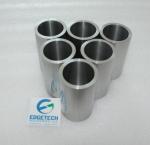Features and uses of different types of crucibles
by Izzy X. Product specialist Crucibles are specialized containers for melting metallic materials at very high temperatures.
Recommended Features
Crucibles are specialized containers for melting metallic materials at very high temperatures.
Recommended Features
- Tungsten crucibles are products made of tungsten metal, which has very high heat resistance. The crucible temperature is as high as 3410C.
- Graphite crucibles are mainly used for casting non-ferrous and ferrous metals. This is due to their non-reactivity, they can withstand very high temperatures.
- Molybdenum is a naturally ductile metal with strong corrosion resistance. Apart from tantalum and tungsten, molybdenum is known to have the highest melting point of the pure elements.
- Silicon carbide crucibles are highly resistant to extreme temperatures, making them suitable for use in modern laboratories.
- Stainless steel crucibles are made from a single piece of material. They are not as fragile as porcelain crucibles.
Review on Features and uses of different types of crucibles
. Be aware that steel crucibles will rapidly scale and flake, and will contaminate the final alloy.Crucibles are made of ceramic materials that can withstand very high temperatures, and they must have a much higher melting point than the material melted in the crucible. Crucibles can also be made of metals such as tungsten and molybdenum to produce tungsten and molybdenum crucibles.
Related to Features and uses of different types of crucibles
Related Articles
Outlook on Global Advanced Ceramics Market
Bharat Book Bureau provides the report, on “ Outlook on Global Advanced Ceramics Market." This report provides detailed market and segment level data on the Global and Chinese consumption...Sponsor Ads
Created on Aug 30th 2023 00:32. Viewed 144 times.
Comments
No comment, be the first to comment.




